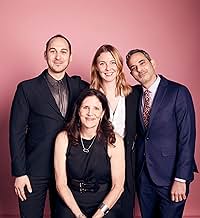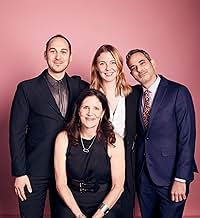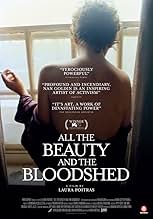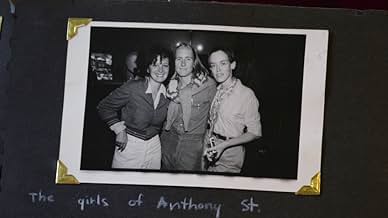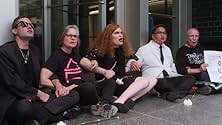IMDb रेटिंग
7.5/10
8.8 हज़ार
आपकी रेटिंग
कलाकार नान गोल्डिन के जीवन और सैकलर परिवार के पतन के बाद, फार्मास्युटिकल राजवंश जो ओपिओइड महामारी की अथाह मौत के लिए बहुत ज़िम्मेदार था.कलाकार नान गोल्डिन के जीवन और सैकलर परिवार के पतन के बाद, फार्मास्युटिकल राजवंश जो ओपिओइड महामारी की अथाह मौत के लिए बहुत ज़िम्मेदार था.कलाकार नान गोल्डिन के जीवन और सैकलर परिवार के पतन के बाद, फार्मास्युटिकल राजवंश जो ओपिओइड महामारी की अथाह मौत के लिए बहुत ज़िम्मेदार था.
- 1 ऑस्कर के लिए नामांकित
- 36 जीत और कुल 57 नामांकन
Robert Drain
- Self - Judge
- (as Judge Robert Drain)
David Armstrong
- Self - Photographer and Friend of Nan
- (आर्काइव फ़ूटेज)
Bruce Balboni
- Self - Actor
- (आर्काइव फ़ूटेज)
फ़ीचर्ड समीक्षाएं
I read the review by CinemaSerf and had similar reaction: I had expected much more of an exposé of the Sacklers. The documentary assumed that viewers would just take the side of the protesters against Sackler, but anyone with an enquiring mind might just wonder what the evidence was. I was in the fortunate position of having read Empire of Pain by Patrick Radden Keefe, which does a thorough and gripping account of the origins of the Sackler family and all their dodgy dealings, pushing opioid drugs to physicians, and recommending alarmingly high doses while arguing that only certain types of people got addicted. Once you have that background, any doubts about Nan Goldin's activism are dispelled, and you look in awe at what she's done. In effect, this film, which is quirky and relies mainly on vision and sound rather than words to convey messages, complements the scholarly verbal account in Empire of Pain. The Sackler story is only part of it - it sits in the context of Nan Goldin's remarkable life and career as photographer documenting the underground life of unconventional people after she escaped her dysfunctional family. It's an important film documenting an era in history, and showing how individuals can take on the rich and powerful. Nan features in Patrick Radden Keefe's book, and he features in her film, but I think that if you put the two together, it's perfect and the whole is greater than the parts.
Another important story to tell but the film itself is lacking some of that connection I'm expecting to feel.
The choice to weave Nan's personal, artistic and activism journey all together is an interesting but risky one because it weakens the delivery on either one of them.
Personally, it feels like the film is putting Nan on a pedestal, instead of where she was most of her life, the dark, dirty and forgotten edges of the city. As a result, her on screen persona sometimes feels even more out of touch than a fictional character.
For what it's worth, the film comes back to the title in the end where it ties All The Beauty And The Bloodshed that Nan has seen throughout her whole life with who she is and what she is trying to achieve now. But it's just a little bit too late for my liking.
The choice to weave Nan's personal, artistic and activism journey all together is an interesting but risky one because it weakens the delivery on either one of them.
Personally, it feels like the film is putting Nan on a pedestal, instead of where she was most of her life, the dark, dirty and forgotten edges of the city. As a result, her on screen persona sometimes feels even more out of touch than a fictional character.
For what it's worth, the film comes back to the title in the end where it ties All The Beauty And The Bloodshed that Nan has seen throughout her whole life with who she is and what she is trying to achieve now. But it's just a little bit too late for my liking.
All the Beauty and the Bloodshed can join Fire of Love in the club of Oscar-nominated documentaries from 2022 that would have been more worthy winners than Navalny. It's admittedly a small club, but I feel like both of those movies have moments that demonstrate documentary filmmaking at its best.
In the case of All the Beauty and the Bloodshed, it's probably the final 15-20 minutes that shines the brightest. It can be a slow and somewhat uneven feeling documentary at some points, but it builds to some phenomenal and emotionally hard hitting final scenes. The rest of the documentary still tends to hit far more often than it misses, but I did get the sense it may have been a tiny bit too long, and while I respect the choice not to tie together its two primary narratives more explicitly, part of me was waiting for them to collide more directly at a point. Still, leaving some of that up to the viewer felt like a deliberate choice, and I can respect that.
It follows Nan Goldin, with the film both recounting her life story from the 1950s to the 1990s and detailing her activism against the Sackler family and their role in the opioid epidemic in the 2010s. The latter might be more interesting narratively, but the former has the more interesting presentation, seeing as Goldin's an accomplished artist/photographer, and the documentary frequently relies on her work to serve as visuals.
It's a heavy and often sad documentary, dealing with mental illness, addiction, corruption, censorship, the AIDS crisis, discrimination, and domestic violence. It might be upsetting to some viewers as a result, but I think it was best not to pull punches (so long as people know what they're in for before deciding to watch it). It's a largely powerful documentary that I think will stick with me. Not perfect, but it has some amazing sequences that were very striking and moving.
In the case of All the Beauty and the Bloodshed, it's probably the final 15-20 minutes that shines the brightest. It can be a slow and somewhat uneven feeling documentary at some points, but it builds to some phenomenal and emotionally hard hitting final scenes. The rest of the documentary still tends to hit far more often than it misses, but I did get the sense it may have been a tiny bit too long, and while I respect the choice not to tie together its two primary narratives more explicitly, part of me was waiting for them to collide more directly at a point. Still, leaving some of that up to the viewer felt like a deliberate choice, and I can respect that.
It follows Nan Goldin, with the film both recounting her life story from the 1950s to the 1990s and detailing her activism against the Sackler family and their role in the opioid epidemic in the 2010s. The latter might be more interesting narratively, but the former has the more interesting presentation, seeing as Goldin's an accomplished artist/photographer, and the documentary frequently relies on her work to serve as visuals.
It's a heavy and often sad documentary, dealing with mental illness, addiction, corruption, censorship, the AIDS crisis, discrimination, and domestic violence. It might be upsetting to some viewers as a result, but I think it was best not to pull punches (so long as people know what they're in for before deciding to watch it). It's a largely powerful documentary that I think will stick with me. Not perfect, but it has some amazing sequences that were very striking and moving.
It still amazes me how evolved the documentary film genre has become over the years.
The amount of freedom you can experiment within a documentary has become more noticeable. In this one particularly, you see a bunch of different styles and even story branches.
There is a mix of themes such as topical activism, what can be classified as art, a determination for justice and accountability, a woman's struggling life and the power of family.
The central character I had no idea about and we certainly got a thorough look into her life both as an artist and as a daughter.
It felt very definitive as I felt it gave you the perfect portrait of this person's upbringing and how certain traumas lead to this groundbreaking change in the art world.
I also liked at how they told each aspect of her life in a parallel style. The timings of shift to a different part of her life felt well-timed and gave us a very satisfying conclusion.
This was pretty interesting and while I wasn't overwhelmed by it, I can see others feeling that way.
It's well made, the content and imagery is strong and the central character was not afraid to open herself up to her life story.
The amount of freedom you can experiment within a documentary has become more noticeable. In this one particularly, you see a bunch of different styles and even story branches.
There is a mix of themes such as topical activism, what can be classified as art, a determination for justice and accountability, a woman's struggling life and the power of family.
The central character I had no idea about and we certainly got a thorough look into her life both as an artist and as a daughter.
It felt very definitive as I felt it gave you the perfect portrait of this person's upbringing and how certain traumas lead to this groundbreaking change in the art world.
I also liked at how they told each aspect of her life in a parallel style. The timings of shift to a different part of her life felt well-timed and gave us a very satisfying conclusion.
This was pretty interesting and while I wasn't overwhelmed by it, I can see others feeling that way.
It's well made, the content and imagery is strong and the central character was not afraid to open herself up to her life story.
As "All the Beauty and the Bloodshed" (2022 release; 118 min.) opens, it is "March 10, 2018", and a group of activists is staging a protest at the Met, more particularly the Sackler Wing. We then go to "1. Merciless Logic" as Nan Goldin starts talking about her early youth, and how her sister Barbara commits suicide when Nan was only 7. At this point we are less than 10 minutes into the film.
Couple of comments: this is the latest from well respected documentarian Laura Poitras ("Citizenfour"). Here she brings us a nuanced portrait and assessment of photographer Nan Goldin, best known for documenting the NY underground scene in the 70s and 80s. At the same time Poitras looks back at the mysterious suicide of Nan's sister Barbara in 1965. And last but not least, Poitras follows Goldin and other members of the activist group P. A. I. N. in their attempts to hold the Sackler family which owns Purdue Company, manufacturer of Valium and Oxycontin, responsible for the opioid crisis in this country (Goldin herself is a survivor of Oxycontin addiction). The beauty of this documentary consisting of 7 chapters is how these three subjects are woven together, with Goldin herself narrating much of it. I was absolutely fascinated by it all, and I am already going on record that this documentary is a shoo-in to get a Best Documentary Oscar nomination.
"All the Beauty and the Bloodshed" premiered at last Fall's Venice Film Festival to immediate critical acclaim, winning the festival's top prize along the way. It is currently rated 93% Certified Fresh on Rotten Tomatoes, and for very good reasons. I see a LOT of documentaries, and surely this is one of the very best, if not THE best, documentaries of 2022, and also one of the very best movies of 2002, period. The documentary opened this weekend at my local arthouse theater here in Cincinnati. The Tuesday evening screening where I saw this at was attended very nicely (I counted about 25-30 people). If you like a top-notch documentary, I'd readily suggest you check this out, and draw your own conclusion.
Couple of comments: this is the latest from well respected documentarian Laura Poitras ("Citizenfour"). Here she brings us a nuanced portrait and assessment of photographer Nan Goldin, best known for documenting the NY underground scene in the 70s and 80s. At the same time Poitras looks back at the mysterious suicide of Nan's sister Barbara in 1965. And last but not least, Poitras follows Goldin and other members of the activist group P. A. I. N. in their attempts to hold the Sackler family which owns Purdue Company, manufacturer of Valium and Oxycontin, responsible for the opioid crisis in this country (Goldin herself is a survivor of Oxycontin addiction). The beauty of this documentary consisting of 7 chapters is how these three subjects are woven together, with Goldin herself narrating much of it. I was absolutely fascinated by it all, and I am already going on record that this documentary is a shoo-in to get a Best Documentary Oscar nomination.
"All the Beauty and the Bloodshed" premiered at last Fall's Venice Film Festival to immediate critical acclaim, winning the festival's top prize along the way. It is currently rated 93% Certified Fresh on Rotten Tomatoes, and for very good reasons. I see a LOT of documentaries, and surely this is one of the very best, if not THE best, documentaries of 2022, and also one of the very best movies of 2002, period. The documentary opened this weekend at my local arthouse theater here in Cincinnati. The Tuesday evening screening where I saw this at was attended very nicely (I counted about 25-30 people). If you like a top-notch documentary, I'd readily suggest you check this out, and draw your own conclusion.
क्या आपको पता है
- ट्रिवियाThe title of the film is a reference to Nan Goldin's older sister, Barbara Holly Goldin. It's a direct quote from a mental health evaluation of Barbara during her time at an institution. She died by suicide in 1965, at the age of 18. This film and Nan Goldin's 1986 "The Ballad of Sexual Dependency" are dedicated to her.
- भाव
Self - Nan's Mother: Droll thing life is -- that mysterious arrangement of merciless logic for a futile purpose. The most you can hope from it is some knowledge of yourself -- that comes too late -- a crop of inextinguishable regrets. Joseph Conrad, Heart of Darkness
- साउंडट्रैकThe Cold Song
Performed by Klaus Nomi
टॉप पसंद
रेटिंग देने के लिए साइन-इन करें और वैयक्तिकृत सुझावों के लिए वॉचलिस्ट करें
- How long is All the Beauty and the Bloodshed?Alexa द्वारा संचालित
विवरण
- रिलीज़ की तारीख़
- कंट्री ऑफ़ ओरिजिन
- आधिकारिक साइटें
- भाषा
- इस रूप में भी जाना जाता है
- Hayatın Tüm Acıları ve Güzellikleri
- फ़िल्माने की जगहें
- न्यूयॉर्क शहर, न्यूयॉर्क, संयुक्त राज्य अमेरिका(Metropolitan Art Museum protest)
- उत्पादन कंपनियां
- IMDbPro पर और कंपनी क्रेडिट देखें
बॉक्स ऑफ़िस
- US और कनाडा में सकल
- $5,00,082
- US और कनाडा में पहले सप्ताह में कुल कमाई
- $28,803
- 27 नव॰ 2022
- दुनिया भर में सकल
- $14,83,975
- चलने की अवधि1 घंटा 53 मिनट
- रंग
- ध्वनि मिश्रण
- पक्ष अनुपात
- 1.78 : 1
इस पेज में योगदान दें
किसी बदलाव का सुझाव दें या अनुपलब्ध कॉन्टेंट जोड़ें




